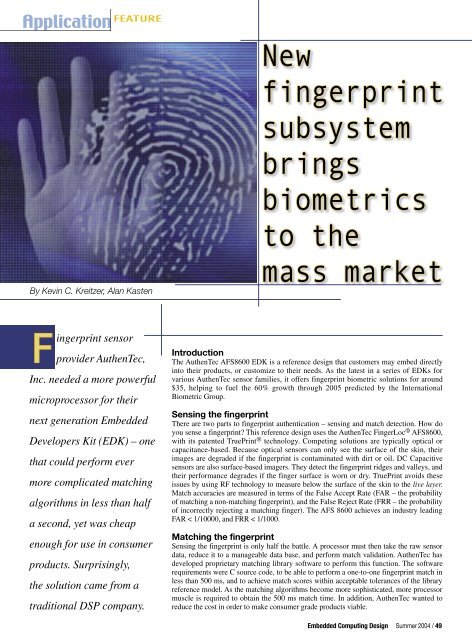Embedded Computing Design - OpenSystems Media
Embedded Computing Design - OpenSystems Media
Embedded Computing Design - OpenSystems Media
Create successful ePaper yourself
Turn your PDF publications into a flip-book with our unique Google optimized e-Paper software.
By Kevin C. Kreitzer, Alan Kasten<br />
New<br />
fingerprint<br />
subsystem<br />
brings<br />
biometrics<br />
to the<br />
mass market<br />
Fingerprint sensor<br />
provider AuthenTec,<br />
Inc. needed a more powerful<br />
microprocessor for their<br />
next generation <strong>Embedded</strong><br />
Developers Kit (EDK) – one<br />
that could perform ever<br />
more complicated matching<br />
algorithms in less than half<br />
a second, yet was cheap<br />
enough for use in consumer<br />
products. Surprisingly,<br />
the solution came from a<br />
traditional DSP company.<br />
Introduction<br />
The AuthenTec AFS8600 EDK is a reference design that customers may embed directly<br />
into their products, or customize to their needs. As the latest in a series of EDKs for<br />
various AuthenTec sensor families, it offers fingerprint biometric solutions for around<br />
$35, helping to fuel the 60% growth through 2005 predicted by the International<br />
Biometric Group.<br />
Sensing the fingerprint<br />
There are two parts to fingerprint authentication – sensing and match detection. How do<br />
you sense a fingerprint This reference design uses the AuthenTec FingerLoc ® AFS8600,<br />
with its patented TruePrint ® technology. Competing solutions are typically optical or<br />
capacitance-based. Because optical sensors can only see the surface of the skin, their<br />
images are degraded if the fingerprint is contaminated with dirt or oil. DC Capacitive<br />
sensors are also surface-based imagers. They detect the fingerprint ridges and valleys, and<br />
their performance degrades if the finger surface is worn or dry. TruePrint avoids these<br />
issues by using RF technology to measure below the surface of the skin to the live layer.<br />
Match accuracies are measured in terms of the False Accept Rate (FAR – the probability<br />
of matching a non-matching fingerprint), and the False Reject Rate (FRR – the probability<br />
of incorrectly rejecting a matching finger). The AFS 8600 achieves an industry leading<br />
FAR < 1/10000, and FRR < 1/1000.<br />
Matching the fingerprint<br />
Sensing the fingerprint is only half the battle. A processor must then take the raw sensor<br />
data, reduce it to a manageable data base, and perform match validation. AuthenTec has<br />
developed proprietary matching library software to perform this function. The software<br />
requirements were C source code, to be able to perform a one-to-one fingerprint match in<br />
less than 500 ms, and to achieve match scores within acceptable tolerances of the library<br />
reference model. As the matching algorithms become more sophisticated, more processor<br />
muscle is required to obtain the 500 ms match time. In addition, AuthenTec wanted to<br />
reduce the cost in order to make consumer grade products viable.<br />
<strong>Embedded</strong> <strong>Computing</strong> <strong>Design</strong> Summer 2004 / 49
















